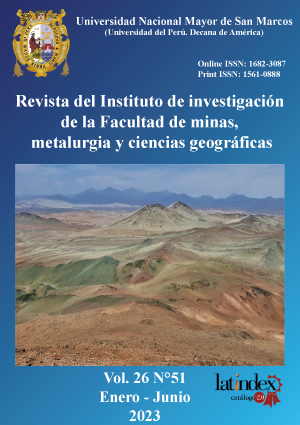Recovery of copper, zinc, gold and silver from polymetallic ores in oxidative ammonia leaching solution
DOI:
https://doi.org/10.15381/iigeo.v26i51.25263Keywords:
copper leaching, gold leaching, oxide and sulfides leach, polymetallic ores leach, silver leaching, zinc leachingAbstract
In the southern part of Peru, it is found Zn-Pb-Cu-Ag-Au mix ore carbonate deposits and polymetallic sulfides in volcanic rocks. It is known that such types of ores are difficult to process, so this ore was tested by leaching using solutions containing hydrogen peroxide and ammonia (H2O2 / NH3); which are, respectively, the oxidant and the complexings agent. Lab work was done with a mix ore, (oxides and sulfides), containing copper, silver, gold and zinc in the form of chalcopyrite, bornite, brochantite, proustite, marmatite, pyrite and few amounts of lead oxide; gangue, basically carbonates. Using H2O2 / NH3, and pH fixed between 9 to 10, metallic recovery was gotten close to 90 % for copper, gold, silver and zinc. Lead and iron do not dissolve in alkaline solution. Metals recovery was done by redox cementation with metallic zinc, which allowed gold, silver, and copper precipitation, the remaining zinc was recovered by electrowinning.
Production costs are quite similar to the traditional leaching methods, standing out that precious metals can be recovered together with base metals. Also, favorably is the fact that equipment and facilities could be set for small metallurgical plants.
Downloads
Published
Issue
Section
License
Copyright (c) 2023 Álvaro José Ordoñez Nuñez, Edmundo Abdul Alfaro Delgado

This work is licensed under a Creative Commons Attribution 4.0 International License.
AUTHORS RETAIN THEIR RIGHTS:
a. Authors retain their trade mark rights and patent, and also on any process or procedure described in the article.
b. Authors retain their right to share, copy, distribute, perform and publicly communicate their article (eg, to place their article in an institutional repository or publish it in a book), with an acknowledgment of its initial publication in the Rev. Inst. investig. Fac. minas metal cienc. geogr.
c. Authors retain theirs right to make a subsequent publication of their work, to use the article or any part thereof (eg a compilation of his papers, lecture notes, thesis, or a book), always indicating the source of publication (the originator of the work, journal, volume, number and date).






